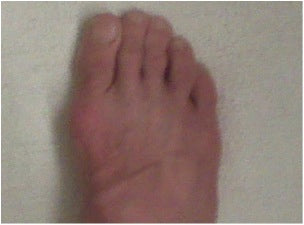"I do think the incidence of second met stress fractures probably has a lot to do with neglecting the hallux set. If the big toe is weak or underutilized, mechanical loading seems to shift to the outer toes. This is often seen as 'duck-walking' where people walk with their feet canted outwards; they're making up for lack of big-toe stability by spreading their feet."Joe, like me, has benefitted significantly from Lee Saxby's (and Jay Dicharry's) advice on pressing down and therefore engaging the big toe while running.
His comment crystalized something I've been thinking about since applying this advice myself, and re-reading D'Aout's paper, The effects of habitual footwear use: foot shape and function in native barefoot walkers (PDF).
D'aout et al found:
"Applying this statistical method to the three groups revealed highly significant differences between [Shod Indian] and [Western] and most clearly, between [Barefoot Indian] and W. Western subjects displayed higher relative pressures in the heel and under the second to third metatarsal head, but lower relative pressures in the midfoot and the toe region (Figure 9)."In figure 6 from that paper, you can clearly see the difference in where pressure is applied between barefoot and shod feet.
If you're not engaging your big toe (the highest pressure point in the bare foot), your body needs to bear that weight somewhere, so it goes on the next-best place, the second and third met heads.
There's the genesis of your second and third metatarsal stress fractures.
 |
| This is not good. See that bent big toe? |
Why doesn't the big toe engage more? I tried this test on my thumb (the equivalent structure from the hand): straighten your thumb out to the side so you can effect maximum pressure when pushing, and push hard. Feels fine. (I wound up hurting my hand doing this next step: I don't suggest repeating.) Then try bending your thumb toward the other fingers and press. Much less pressure, and it hurts. Since the big toe is bent, by your shoes, you can't engage the same pressure.
This is something Mark Cucuzzella talks about, and is the reason he wears Correct Toes when running shod. (Mark's also a fan of Jay's advice about pressing the big toe.)
Now as Pete Larson observes (in a post also inspired by Joe):
"...Clearly, fractures of the 2nd metatarsal are occurring in individuals who give minimalist running a try (for example, check out this great post by Joe Maller), but it’s also important to keep in mind that this is the most common type of foot fracture in shod runners as well. The big question, for which we don’t yet have an answer, is whether incidence is in fact higher among minimalist runners...."Sadly, we're missing an important bit of information here: the incidence of second (and third) metatarsal stress fractures among the habitually barefoot. A quick search of Google Scholar for the phrase "metatarsal stress fracture barefoot india" turns up nothing.
But, this study, Comparison of static and dynamic biomechanical measures in military recruits with and without a history of third metatarsal stress fracture, and this article, Pronation in runners: Implications for injury offer two hints, confirming Joe's hypothesis:
"...If the big toe is weak or underutilized, mechanical loading seems to shift to the outer toes. This is often seen as 'duck-walking' where people walk with their feet canted outwards; they're making up for lack of big-toe stability by spreading their feet."The Pronation article includes the following image (included with explanatory caption):
"Duck-walking" is known in scientific terms as "rearfoot eversion", as you can see. That picture looks very familiar to me: I run like B, although as I continue engaging my big toe, I look more and more like A.
And sure enough, from the Military Stress Fracture paper:
And just to be clear: these are not injuries of barefoot-style running. These are injuries caused by the wearing of shoes.
And sure enough, from the Military Stress Fracture paper:
"During running, peak rearfoot eversion was found to occur significantly earlier for the stress fracture group than for their matched controls, suggesting an increase in time spent loading the forefoot. The peak applied resultant horizontal force during the braking phase was directed significantly more laterally for the stress fracture group. In addition, the peak magnitude of resultant horizontal force applied during the propulsion phase was significantly lower for the stress fracture subjects."Dr. Simon Wikler offers a similar description in his book Take Off Your Shoes And Walk:
"...when baby first starts to walk, he stands with his feet pointed out in a fallen-arched manner in order to balance himself. For a toddler this is normal. When a few months later, he acquires strength (if his feet and toes have not been weakened and distorted by shoes), he will by himself abandon the fallen-arched gait and stance."Sadly, for Joe, myself, and the majority of the shod world, our feet never get the chance to develop normally. Our development is retarded by wearing shoes all the time; we never properly develop our hallux, or worse, it's deformed, as in the picture of Mark Cucuzzella's feet above; and we suffer the resultant injuries of metatarsal-cuboid joint pain and iliotibial band syndrome (my case) or stress fractures of the over-stressed second and third metatarsal bones (Joe's case).
And just to be clear: these are not injuries of barefoot-style running. These are injuries caused by the wearing of shoes.


Yes...pose recommends the balls of the feet also :)
ReplyDelete